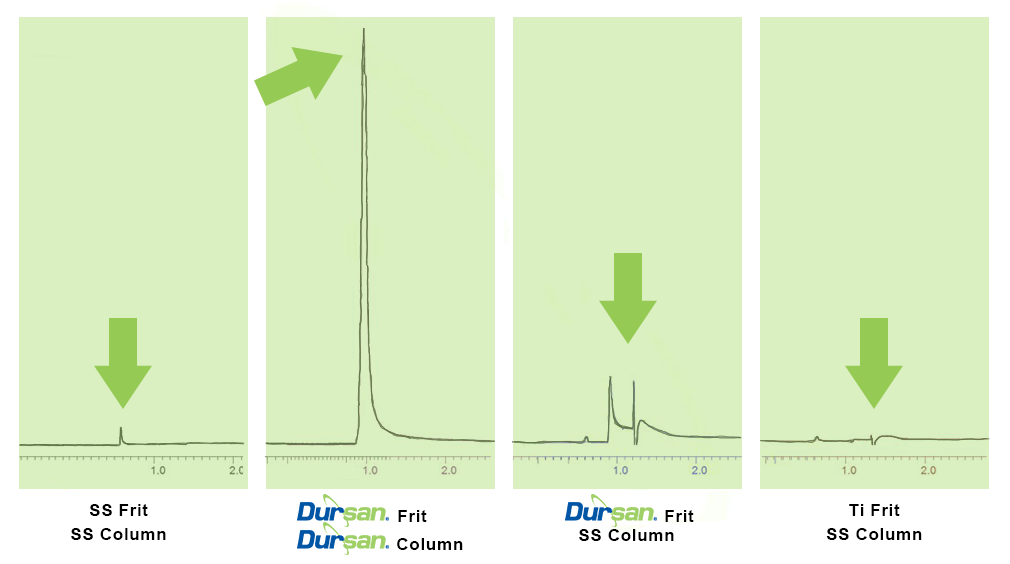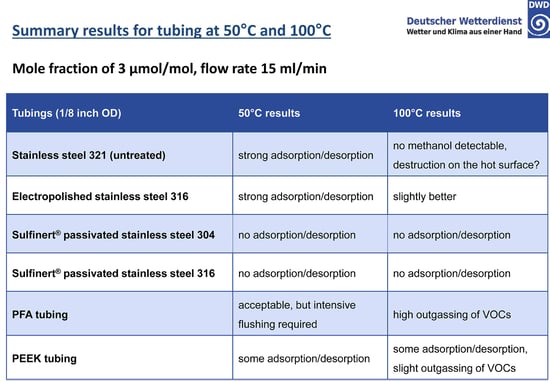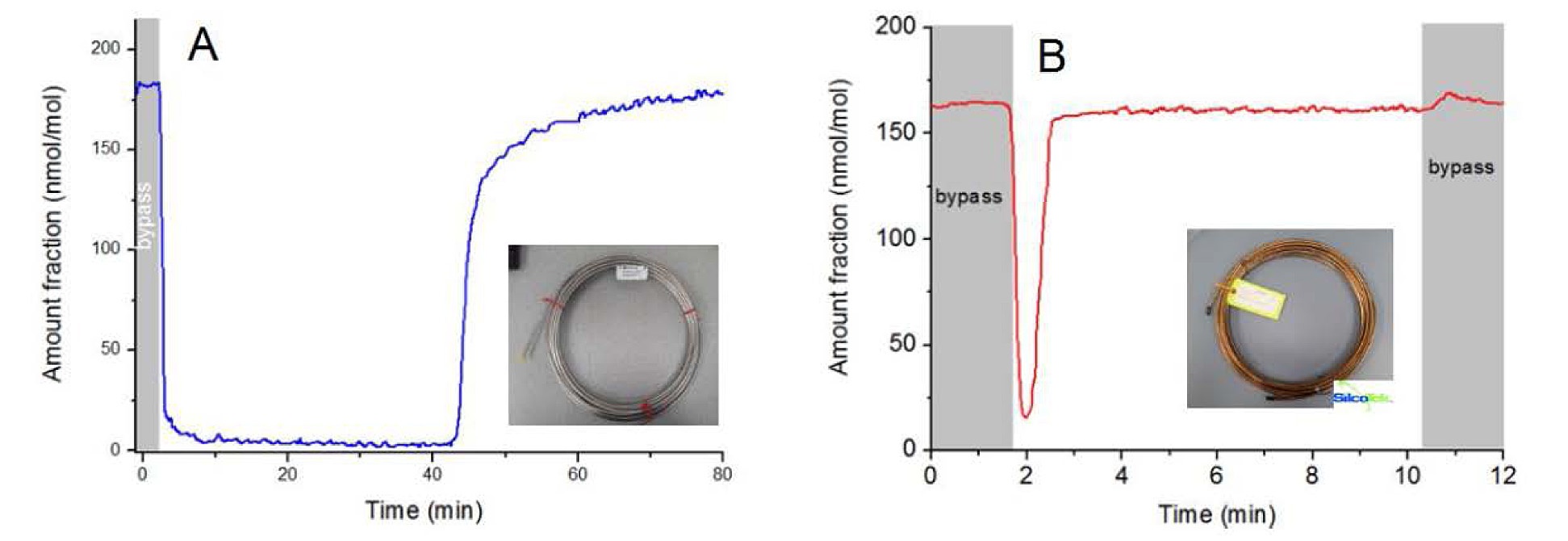
We discuss how SilcoNert coated sample pathways are used in an innovative way to test metabolic rate during exercise.
Monitoring VOCs in Innovative Ways
An interesting paper featuring an interesting method for measuring trace levels of volatile organic compounds (VOCs) during exercise was recently published. The researchers analyzed participant’s exhaled breath for VOCs during exercise. The objective of the test was to measure VOCs in real-time rather than the traditional test method of drawing blood and sending the sample to the lab for analytical blood work. The objective of the test wasn't so much looking for patterns in the VOCs or how levels impact exercise; the test was more focused on validating that the experimental set-up works and is an effective measurement method.
The test utilized SilcoNert 2000 coated tubes to connect the user's mask to a mas spec. The SilcoNert coated flow path assured that the VOCs would not get stuck in the transport tubing before measurement.
Details of the Test
Why measure exhaled breath during exercise?
The test method offers a non-invasive and real-time monitoring method designed to measure how the body is performing during exercise. The test sampling technique and SilcoNert® coated flow paths allow the mass spectrometer to detect changes in metabolite levels when compared to a resting body. The test utilized secondary electrospray high resolution mass spectrometry (SESI-HRMS) to measure VOC levels. The test enabled the researchers to detect trace VOCs and obtain high-resolution metabolite shifts during a graded cycle ergometry cardiopulmonary test, called CPET. The test was able to detect significant changes in metabolites during the exercise regimen.
The test measured trace levels of glyoxylate and dicarboxylate, tricarboxylic acid cycle (TCA), and tryptophan to assess metabolic changes.
Read the entire study.

How Coatings improve VOC Detection
 *Precise detection of trace compounds in odorants, breath, or the environment require surfaces that minimize adsorption and contamination by the analyte flow path. Olfactory detection and analytical systems must clearly and repeatably detect trace compounds in the part-per-billion range. In order to achieve reliable ultra low level detection the flow path surface must allow all the sample to reach the HPLC, GC (gas chromatograph) or GC-MS (gas chromatograph, mass spectrometer) detector. Here's an example of how the surface can change trace analysis results.
*Precise detection of trace compounds in odorants, breath, or the environment require surfaces that minimize adsorption and contamination by the analyte flow path. Olfactory detection and analytical systems must clearly and repeatably detect trace compounds in the part-per-billion range. In order to achieve reliable ultra low level detection the flow path surface must allow all the sample to reach the HPLC, GC (gas chromatograph) or GC-MS (gas chromatograph, mass spectrometer) detector. Here's an example of how the surface can change trace analysis results.

In this example we're comparing a prepared, known sample concentration in an HPLC (High Performance Liquid Chromatography) system. The first chromatogram shows the results when testing with a stainless steel frit and stainless steel column in the flow path. As you can see there is very little signal response, indicating flow path adsorption and loss of sample. This makes precise trace detection of target compounds difficult.
The next chromatogram shows the same set-up and sample but with a Dursan® coated frit and column. The peak is much larger and shows minimum tailing or distortion. This indicates that all the sample is reaching the column and detector without flow path adsorption. Making consistent detection of trace compounds for VOC analysis or odor detection possible.
The other chromatograms at the right show how the same sample peak can be distorted when even part of the flow path is reactive.
 There's a wealth of information available from companies like Agilent and Restek that offer all the information needed to select the right column and components for your system. SilcoTek is here to help you select the best coating for your application. Try our coating selector or read about our coating properties.
There's a wealth of information available from companies like Agilent and Restek that offer all the information needed to select the right column and components for your system. SilcoTek is here to help you select the best coating for your application. Try our coating selector or read about our coating properties.
Go to Our Coating Selector Guide
Information is also available for help when detecting aromatics, VOCs, odors, and fragrances using metal capillary column analysis that feature inert silicon coated stainless steel columns (called Siltek® by Restek).
Trace VOC Detection and Test Data
Odor, breath, or environmental monitoring detection often relies on the sample system's ability to detect airborne volatile organic compounds (VOCs). Analytical systems often require the use of sample transport tubing or stainless steel valve or fittings to transport and regulate the flow of the test sample. Stainless steel components will adsorb reactive compounds and prevent reliable measurement of trace VOCs. Analytical performance can be improved by using SilcoNert coated stainless steel tubing, valves, fittings and other critical flow path and instrument components.
Testing by Mr. Stefan (S.T.) Persijn of VSL, Dutch Meterlogical Society, (in conjunction with the German Meterological Office, DWD) presented a comparative study of adsorptive properties of various materials commonly used in VOC analysis. (in the comparison the tradename Sulfinert® was used)
Read The VOC Presentation
The study exposed various tube surfaces to methanol at 50 and 100°C and measured adsorption rate of the surfaces. Results show that an inert coating like SilcoNert® coated stainless steel prevented adsorption and reaction with VOCs in critical flow paths. The study summary, below, highlights the comparative results:

The untreated stainless steel readily adsorbs volatile organic compounds. Electropolishing will smooth the surface and reduce overall surface area but adsorption is still significant. PFA and PEEK tubing require careful management of the surface in order to achieve acceptable results. SilcoNert® (in this study called by our other trade name, Sulfinert® ) coated stainless steel does not adsorb active compounds because the inert silicon CVD surface bonds to and diffuses into the stainless steel substrate, preventing interaction with reactive sites.
Methanol Comparison
The VOC team then compared 10 meter lengths of SilcoNert® 2000 coated and uncoated stainless steel tubing (below). The team passed a 180 umol/mol methanol mixture through a bypass (grey areas), then switched to the test tubing. They measured the time to achieve baseline concentration for each tube. The SilcoNert coated tube took less than a minute to stabilize (graph B) compared to over 40 minutes for the stainless steel tube (graph A). The comparison demonstrates the severe adsorption of trace methanol and VOCs on stainless steel flow path surfaces and highlights potential delays in response that can lead to significant data reliability issues when conducting trace VOC analysis.**

Overall the least methanol adsorption was observed for polymer sampling lines (like PTFE, and FEP) but porosity/permeability, high temperature stability and durability issues limit their effectiveness in the field. It was found that at elevated temperatures (50 to 100°C) polymer tubing emitted trace compounds which can lead to unwanted or spurious signal peaks. The SilcoNert coating is stable to 400°C or more and emits no trace compounds during heating.
The study stated:
"The adsorption by most polymers such as PTFE and FEP is extremely low, while for uncoated metals it is very high. Coated stainless steel with SilcoNert-2000 (also known as Sulfinert) are the preferred choice, as they also have the benefit of being robust non-permeating materials."
To learn more about how to improve tests in challenging environments, read our e-book. Click the box below to get tips on improving the quality of your analytical results. And help you to save money!

Coating Components to Improve Performance: Where to Buy
 You can buy SilcoTek® treated analytical components designed for VOC analysis, analytical testing and many other applications from several sources. Companies like Gerstel offer olfactory sensory components designed to enhance the detection of airborne compounds. You can also buy coated GC and GC-MS flow path components from Restek, Analytical Flow Products, Markes International and others. Go to our Buy Coated Products page to get access to lots of manufacturers that offer coated sampling components designed to improve analysis.
You can buy SilcoTek® treated analytical components designed for VOC analysis, analytical testing and many other applications from several sources. Companies like Gerstel offer olfactory sensory components designed to enhance the detection of airborne compounds. You can also buy coated GC and GC-MS flow path components from Restek, Analytical Flow Products, Markes International and others. Go to our Buy Coated Products page to get access to lots of manufacturers that offer coated sampling components designed to improve analysis.
Have a question about analytical testing, or testing of VOC compounds? Contact our Technical Service Team to discuss your application. If you'd like to keep up with the latest in high performance coatings, subscribe to our email and blog, or follow us on LinkedIn.

* image credit Greencarreports.com.


 *Precise detection of trace compounds in odorants, breath, or the environment require surfaces that minimize adsorption and contamination by the analyte flow path. Olfactory detection and analytical systems must clearly and repeatably detect trace compounds in the part-per-billion range. In order to achieve reliable ultra low level detection the flow path surface must allow all the sample to reach the HPLC, GC (gas chromatograph) or GC-MS (gas chromatograph, mass spectrometer) detector. Here's an example of how the surface can change trace analysis results.
*Precise detection of trace compounds in odorants, breath, or the environment require surfaces that minimize adsorption and contamination by the analyte flow path. Olfactory detection and analytical systems must clearly and repeatably detect trace compounds in the part-per-billion range. In order to achieve reliable ultra low level detection the flow path surface must allow all the sample to reach the HPLC, GC (gas chromatograph) or GC-MS (gas chromatograph, mass spectrometer) detector. Here's an example of how the surface can change trace analysis results.
 There's a wealth of information available from companies like Agilent and
There's a wealth of information available from companies like Agilent and


 You can buy SilcoTek® treated analytical components designed for VOC analysis, analytical testing and many other applications from several sources. Companies like Gerstel offer
You can buy SilcoTek® treated analytical components designed for VOC analysis, analytical testing and many other applications from several sources. Companies like Gerstel offer
